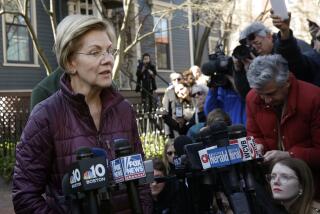Is lending REALLY the riskiest thing banks do?
- Share via
Some ideas are so preposterous on their face that the only way they can gain currency is by constant, uncritical repetition.
That’s the case with the idea that the “riskiest business banks engage in is lending.” This ridiculous line made its latest appearance Wednesday during the congressional testimony of JPMorgan Chase Chairman Jamie Dimon. It was fed to Dimon by Sen. Bob Corker, R-Tenn., as though straight from the prompter’s box, and got the exact answer Corker was fishing for:
Corker: “Mr. Dimon, you’ve said that the biggest risk a bank takes is making loans, is that correct?”
Dimon: “Yes.”
Let’s unpack this, just for a moment. If what Dimon says is true, he’s essentially pleading that his entire industry is operated by hopeless incompetents.
Lending, in its pure, uncomplicated form, is the least risky thing a bank can do. The bank takes in deposits, paying, say, 1% or 2% a year, and lends them out at 4%, 5%, 6%, 24% (if it’s issuing credit cards). It has every right and incentive to adjust the loan price and other terms to meet the risk profile of the borrower. The bank, then, collects the spread between what it pays for deposits and collects from borrowers, devotes some of that money to reserving against losses, and pockets the rest.
Most important, the typical commercial loan is long term, not due for several years. This significantly reduces the riskiness of the loan. Why? Because it means that a borrower often can suffer business slowdowns without having to pay back the loan on the spot. The bank doesn’t care, as long as the borrower is solvent by the time the loan matures.
So the real risk faced by the bank is that its borrower goes under completely. But those cases are a subset, and probably a small one, of the universe of borrowers who go through slumps but remain in business. The task of keeping that subset as small as possible falls to the bank’s underwriters, who are supposed to be professionals at judging that risk and pricing every loan accordingly.
That’s the model that made traditional banking not only a safe business, but a boringly safe business. Before the 1980s, if you were a banker and knew enough to keep your hands and elbows inside the bus, you couldn’t not make money. Then came deregulation, and banks were allowed, even encouraged, to go wild.
Before that, it didn’t pay to be a smart or creative banker — cleverness worked against the business model. After that, banking began to attract rocket-scientist types, and the harvest came in 2008.
So conventional lending works by smoothing out the highs and lows of the business cycle. Contrast that with the sort of post-1980s derivatives investing that garnered JPMorgan a loss now expected to be $5 billion or more and that brought Dimon before the senators. Derivatives by their nature are short term. Often they have to be valued every day, sometimes twice a day, and the profit or loss recorded on the spot. They don’t smooth over the business cycle — they magnify the business cycle.
Moreover, the potential losses are unpredictable. Make a $1-million loan to a surfwear manufacturer, and the most you can lose on it is $1 million. Make a derivatives investment, and ... well just remember that the “value at risk” in the derivatives trade that brought JPM low soared from $67 million per day to $129 million per day, over a period of a few weeks.
The most fatuous exchange in Corker and Dimon’s nationally televised pillow talk came when the senator asked the banker what would happen if Morgan wasn’t allowed, in principle, to do the kind of hedging that produced the big loss.
“You might have less loans,” Dimon said.
Yet JPM made its derivatives investment with more than $300 billion in spare cash that it had on hand precisely because it hadn’t used it for lending. If it had used it for lending, it certainly looks like its risk would have been a lot lower.
Related:
What Dimon didn’t say on “Meet the Press”
Will Dimon now shut up about the Volcker Rule?
More to Read
Inside the business of entertainment
The Wide Shot brings you news, analysis and insights on everything from streaming wars to production — and what it all means for the future.
You may occasionally receive promotional content from the Los Angeles Times.











